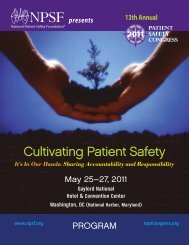NPSF Research Grants Program - NPSF Patient Safety Congress
NPSF Research Grants Program - NPSF Patient Safety Congress
NPSF Research Grants Program - NPSF Patient Safety Congress
Create successful ePaper yourself
Turn your PDF publications into a flip-book with our unique Google optimized e-Paper software.
Upon completing this session, attendees will be able to:<br />
• Describe the guiding principles of the patient-centered approach to care delivery<br />
in general and care coordination along the continuum in particular<br />
• Explain how patients in real clinical settings can and do participate in their own<br />
care along the continuum and why it makes a positive difference in patient<br />
safety as well as patient outcomes and satisfaction<br />
REFORMiNG hEALth CARE/ADvANCiNG QuALitY<br />
AND SAFEtY<br />
SeSSion 505: Partnerships to Reduce Adverse Drug Events<br />
and Readmissions<br />
1.0 contact hours for physicians, pharmacists 232-999-12-150-L05-P<br />
(activity type- Application), nurses, healthcare risk management, healthcare quality<br />
and healthcare executives<br />
Mary Andrawis, PharmD, MPH, <strong>Patient</strong> <strong>Safety</strong> Campaign Lead, Centers for<br />
Medicare and Medicaid Services<br />
Brian J. Isetts, PhD, Professor, University of Minnesota, Health Policy Fellow,<br />
Centers for Medicare and Medicaid Services Innovation Center<br />
Drug-related morbidity and mortality represents a $200 billion burden on the US<br />
health care delivery system. A number of efforts are in place for addressing this<br />
issue. The Partnership for <strong>Patient</strong>s represents a major public-private initiative<br />
to improve safety and effectiveness of care transitions. The Joint Commission<br />
Medication Management Standards have prompted institutions to develop<br />
systems for the surveillance, detection, mitigation, and prevention of adverse drug<br />
events. This session will describe results from organizations that are measuring<br />
improvements in adverse drug events and drug-related readmissions in the<br />
context of Partnership for <strong>Patient</strong>s aims.<br />
Upon completing this session, attendees will be able to:<br />
• Describe the Partnership for <strong>Patient</strong>s core aims to decrease hospital acquired<br />
conditions and to reduce readmissions<br />
• Explain national efforts to promote quality improvement in reducing adverse<br />
drug events and drug-related readmissions.<br />
• Analyze results from aligning the measurement of adverse drug events and<br />
readmissions using examples of patient stories from a few health system partners<br />
ShAPiNG thE CuLtuRE<br />
SeSSion 506: Safe by Design by <strong>Patient</strong>s<br />
1.0 contact hours for health care executives<br />
Martie Carnie, <strong>Patient</strong> and Former Co-Chair of <strong>Patient</strong> and Family Advisory Council,<br />
Dana-Farber Cancer Institute<br />
Janet Porter, PhD, Chief Operating Officer, Dana-Farber Cancer Institute<br />
Engaging patients and families in the planning and design of new health care<br />
facilities helps produce spaces that are safe and comfortable and that facilitate<br />
patient flow. Dana-Farber Cancer Institute called on patients and family members<br />
in the planning and design of an outpatient cancer building, with the patients and<br />
family members driving design. This session describes how to engage patients and<br />
family members in building design and patient flows – from architect selection<br />
through program planning and design development to selecting success metrics to<br />
planning for the move.<br />
FRIDAY<br />
Upon completing this session, attendees will be able to:<br />
• Describe how to involve patient and family members in facility planning and<br />
design and move-in<br />
• Understand the valuable role that patients and family members can play in<br />
advancing thinking about building safety into facility design<br />
• Learn how the voices of patients and family members contribute to embedding<br />
safety in every aspect of design – from arrival through check-out<br />
12:15 PM – 1:45 PM<br />
LEARNiNG & SiMuLAtiON CENtER:<br />
LuNCh, SiMuLAtiONS, EXhiBitS, POStERS<br />
Visit the <strong>NPSF</strong> booth and leave<br />
your business card for a chance<br />
to win a free registration for the<br />
2013 <strong>NPSF</strong> <strong>Congress</strong>. Winners will<br />
be drawn at 1:00 PM on Friday<br />
and must be present to win.<br />
2:00 PM – 3:00 PM<br />
PLENARY<br />
the <strong>Patient</strong> <strong>Safety</strong> Culture Proposition: 16 Design Laws<br />
to Observe, 5 Skills We Must Develop<br />
1.0 contact hours for physicians, pharmacists 232-999-12-151-L05-P<br />
(activity type – Knowledge), nurses, healthcare risk management, healthcare quality<br />
and healthcare executives<br />
David Marx, JD, Chief Executive Officer, Outcome Engenuity LLC<br />
This session will introduce attendees to basic ideas about our ability to collectively<br />
produce better outcomes, the 16 laws that serve as constraints in the design of<br />
socio-technical systems, and the five skills we need to develop. Discussion will<br />
center on five necessary areas of skills: values and expectations, system design,<br />
behavioral choices, learning systems, and justice and accountability, and how<br />
these skills can be applied to the health care concepts and practices that have<br />
been presented throughout the <strong>NPSF</strong> <strong>Congress</strong> program.<br />
Upon completing this session, attendees will be able to:<br />
• Identify the 16 laws that serve as constraints in the design of socio-technical<br />
systems<br />
• Describe the five skills that are necessary to produce better patient safety<br />
outcomes<br />
• Explain how the laws and skills can be applied and implemented from concept<br />
to practice<br />
<strong>Patient</strong> <strong>Safety</strong> 365 15 <strong>NPSF</strong> Annual <strong>Patient</strong> <strong>Safety</strong> <strong>Congress</strong> 2012



